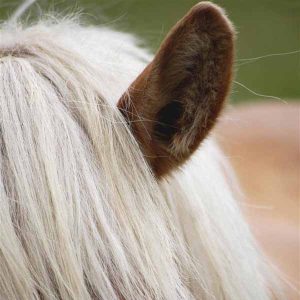
Testing a Horse’s Hearing
People, cats and dogs often suffer from hearing loss due to injury, illness or old age, but what about horses? While complete deafness is easy to diagnose, partial hearing loss in horses is harder to pinpoint. Typically, hearing loss occurs in the higher frequencies first and progresses to the lower ones. Horses are notoriously bad at homing in on where sounds come from by using their ears. Normally they turn in the general direction of a sound and use their keen sense of sight to scan for danger. Therefore, owners don’t often see ear cues that would help them recognize deafness.
Reactions to sound:
One of the most common signs of deafness is a lack of reaction to sound: Perhaps your horse no longer seems to notice when you cluck at her, or he stands calmly when the truck backfires while the rest of the horses in the barn all jump. Often hearing-impaired horses become spookier than normal. Your horse may seem surprised when you come up behind him. One way to test your horse’s hearing is to stand just out of sight and shake a can of grain. You should get a reaction from that! Hearing loss should be suspected in horses that seem to be unresponsive to external noises. It might be hard to determine if your horse is partially deaf because horses are good at compensating with their other senses.
The BAER test:
One way to check a horse’s hearing is to use a brainstem auditory-evoked response test, or BAER test. The test detects the electrical activity in the inner ear and auditory pathways in the brain. The procedure does not require general anesthesia or sedation. Headphones are held over or placed in the horse’s ear and a series of clicking noises at various frequencies are generated to stimulate the auditory pathways. A horse with normal hearing will produce a series of waves; in a horse with deafness, the waves are abnormal or totally absent. Many university veterinary hospitals offer BAER testing.



3 Comments
University of Cincinnati FETCHLAB
Animal audiology clinic / Laboratory
Dr. Hefner is correct and the permissible exposure level used for horses is 85 dB SPL for 8 hours; this value has been repeatedly used in our research and testing.
Good day,
I am trying to find information on how many decibels will start causing damage to horse’s hearing.
If you know or can give me a reference for an article I would really appreciate it.
Kind Regards,
Kevin
Hello Kevin,
Thank you for contacting us. What a good question.
With repeat exposure hearing damage begins at 85 decibels. Physical damage occurs at 150 decibels. Ear drum rupture occurs at 190 decibels. I do not know if this is based on horse specific research or extrapolated from human and other species research. I can find no papers that deal with hearing damage in horse specifically, but that does not mean they don’t exist. I suggest you contact Rickye Heffner, PhD who is a specialist in mammal hearing and should be able to provide the most up to date information.
Dr. Rickeye Heffner
Department of Psychology
University of Toledo
2801 West Bancroft St.
Toledo, Ohio 43606-3390
Office: UH 5008
Phone: 419-530-2710
Fax: (419) 530-8479
Email: rickye.heffner@utoledo.edu
http://psychology.utoledo.edu/showpage.asp?name=rheffner